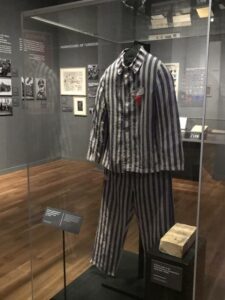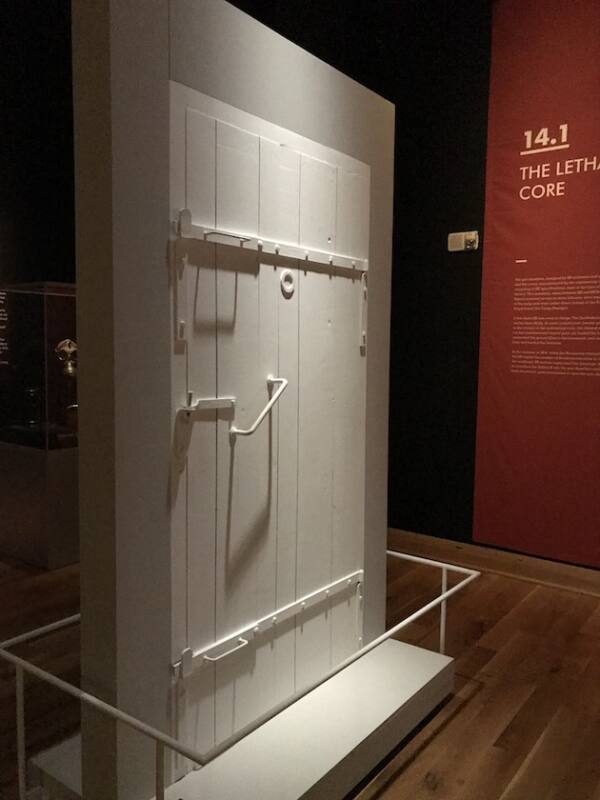The much-anticipated exhibition Auschwitz. Not long ago. Not far away. opened at Union Station in Kansas City this week. Michael Berenbaum, Ph.D., one of the curators, wishes there was no need to revisit those tragic events.
“I wish it were irrelevant,” he told Metro Voice. “The great thing would be if we could say ‘Auschwitz, far away and long ago.’ But the reality is that we live in a world in which democracy is fragile, in which hatred is rampant and in which democratic regimes are becoming authoritarian and authoritarian regimes are becoming totalitarian. We wish Auschwitz were not as relevant. We wish `not long ago, not far away’ were not true,’ but unfortunately, it is true. Part of what this serves to do is remind us of the responsibilities we have in this world to be faithful to the best of our traditions.”
Berenbaum, a Los Angeles-based author, professor, rabbi and museum advisor, attended the opening of the exhibition.

“Union Station opened one of the most important exhibitions in our history”, said George Guastello, Union Station president and CEO. “ Auschwitz. Not long ago. Not far away. is meant to stir the conscience of the world and ensure none of us ever stands by to let the seeds of hatred and indifference grow again. The consequences, otherwise, are devastating. Everyone should make plans to take advantage of this rare opportunity to learn profound lessons from the not-too-distant past.”
The exhibition allows visitors to experience artifacts from the Auschwitz Memorial and Museum including hundreds of personal items — such as suitcases, eyeglasses, and shoes — that belonged to survivors and victims of Auschwitz. Other artifacts include concrete posts that were part of the fence of the Auschwitz camp; fragments of an original barracks for prisoners from the Auschwitz III-Monowitz camp; a desk and other possessions of the first and the longest-serving Auschwitz commandant, Rudolf Höss; a gas mask used by the SS; Picasso’s Lithograph of Prisoner; and an original German-made Model 2 freight wagon used for the deportation of Jews to the ghettos and extermination camps in occupied Poland.
READ: What happened to the babies of Auschwitz?
Union Station is the second and final U.S. location for the exhibition, which will travel to 14 places around the world over seven years.
“About five years ago, Luis Ferrerio (director of the Spanish exhibit sponsor Musealia), made a pitch at the American Association of Museums, and one of the first people to respond was George Guastello,” Berenbaum said. “We couldn’t have imagined how perfect of a setting this is. As you go through the exhibits, the pillars give a sense of industrial power. The nature of how high the ceilings are and the nature of how the building give a sense of the industrialization that is involved in this.”

The lessons of Auschwitz reinforce a lesson that is as old as the human race.
“There is a radical difference between good and evil,” he said. “Humanity is capable of reaching the heights of heaven and of descending into the depths of hell. This is the depths of hell. This is what happens when people do not accept the most fundamental teachings that all human beings are created in the image of God and that all human beings are entitled to respect, decency and dignity. That is regardless of race, religion and the like, and that is because we all are in the divine image.”
The exhibition is opening at a time when anti-Semitism is resurgent in the United States and around the world. “Anti-Semitism is rampant, and hatred is rampant,” Berenbaum said. “This shows where hatred can lead. It doesn’t have to lead there, but that depends on you and me.”
READ: Holocaust survivor says, “I must tell you.”
The events of the past year help visitors better relate to the exhibition.

“The interesting thing about the pandemic is that people can now appreciate the stories of those who lived in hiding,” he said. “We were in hiding against an invisible enemy, and they were in hiding against a visible enemy and had to make themselves invisible.
“The other thing is that I keep hearing students ask somebody who was in hiding is, `what did you do without Zoom, the internet, televisions and radio? How did you maintain your sanity and your humanity?’ Those are questions than people who had not lived in quarantine and in hiding were not asking before.”
Visitors may be surprised to learn that of the approximately 400,000 prisoners registered in Auschwitz, almost half were Christians. One exhibit recognizes the contributions of Corrie ten Boom, author of “The Hiding Place,” and other Christians.
Although the lessons of Auschwitz must never be forgotten, Berenbaum cautions parents to use discretion.
“I don’t recommend that young children 12 and younger come here,” he said. “But remember, there are 10-year-olds who are 20, and there are 20-year-olds who are 10. Every parent should have the discretion to understand what their kids are ready for.”
It also is important to explain the significance of Auschwitz to older children.
“The single most important thing we can tell our kids when they are very young is that the world is safe and we are here to protect you,” Berenbaum said. “This tells you that the world is not safe, and there is nothing parents could do to protect their children. So you have to be a certain age and a certain sophistication to understand that that message doesn’t apply to you in this world.”
Although the exhibition will continue until January, the museum staff recommends making reservations early. Nearly 80,000 tickets already have been sold to visitors from 47 states and dozens of countries. That’s a record for a special exhibition. “Diana” only pre-sold 12,000 tickets.
Auschwitz. Not long ago. Not far away. sheds a bright light not only on the past but many events of the present. “The most important thing people should remember is that there are consequences to hatred,” Berenbaum said.
At a Glance
Dates: Now through Jan. 23, 2022
Hours: 10 a.m. to 6 p.m. (additional hours may be added because of high demand)
Monday through Sunday
Admission fees: Union Station members, $15; Adults, $23.50; Students (ages 3 to 22), $17.50; Seniors (55 or older), $19; Groups, $15
Tickets purchases www.unionstation.org






